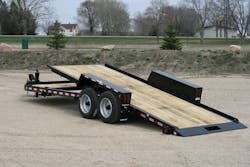Trailers are rather basic—a simple machine, as Troy Geisler, vice president of sales and marketing for Talbert Mfg. Inc., Indiana-based trailer manufacturer since 1938, describes them. Their simplistic design has a purpose: ease of operation and maintenance. “Over-complicating things gets in the way.”
“Customers in our industry are often resistant to changes which add technical complexity to their trailers,” states Jay Kulyk, president of Rogers Brothers Corp, manufacturers of trailers from a 20-ton-capacity Tag-Along drawbar to a detachable gooseneck trailer of over 100-ton capacity. “Trailers are a necessity for many companies, but not generally a source of revenue.” He says many contractors think of them in terms of “one more piece of equipment to maintain,” but firmly believes that “maintenance anxiety is larger than reality.”
Ease of use and safety are the main components of equipment hauling trailers, concludes Arin Laugtug, western territory manager, Towmaster Trailers, known for their flatbed equipment trailers.
Ramping Up
“On a detachable gooseneck trailer, ramps are not very technologically exciting,” Kulyk shrugs. “Most are attached to the very front of the trailer frame using a hinge-type connection and are manually flipped on or off the deck for use. There aren’t many changes you can make: They can be longer or shorter, depending on the requirements of the machinery to be loaded over them.” As for technology, he says there’s “nothing specific” that’s new or advanced—and currently, there’s no efficient way to move them other than manually “unless someone figures out how to use air or hydraulics to do it.”
Instead of adding technology to ramps, Laugtug says there’s been a shift away from them to tilt trailers, although tilt trailers aren’t new. They’ve been around since the 1940s, often preferred because they don’t cause back injuries like lifting heavy ramps can. Not only are tilt trailers injury-free, he continues, but “ramps are no good if the equipment isn’t running” because non-running equipment can’t be driven up on them, making them a more viable option, particularly on smaller trailers, than even hydraulic tail trailers, which raise the tail up after the equipment is loaded.
Used with their Tag-Along and certain other rear loading trailers, Rogers Brothers’ air ramp design, their newest innovation, has taken the place of the traditional spring-assisted manual lifted ramps of previous designs. Air from the trailer’s air brake system inflates an air spring, which is mounted under the trailer, to “push out” lifting bars, eliminating the need for operators to physically raise and lower ramps.
Ultimately, Laugtug believes, equipment dictates the design. Towmaster’s trailers are low to the ground to provide the low load angle necessary for pavers.
“Each type of contractor uses a different type of machine,” he elaborates. Paving contractors use a skid-steer, paver, and roller. For them, Towmaster’s hydraulic bifold ramp that extends the full width of the trailer and has a 7% load angle suits their lower, heavy equipment. But a basement excavator uses a backhoe for utility work and water pipes; for them, Laugtug says standard ramps are suitable.
Contractors who use small equipment—such as landscapers with walk-behind skid-steers—prefer the ramp to be the full width of the trailer, he continues. They also appreciate attachment holders for augers and buckets and a shelf for the trencher.
The Weight
After-market air-weigh scales for trucks and trailers ensure the load and scale weight are legal without being under-loaded. That may be more important than ever for several reasons beyond budget and efficiency. As Laugtug explains, skid-steers, CTLs, and mini excavators are getting heavier. “Compact equipment has doubled in size. Now, the machines are 12,000 pounds plus.”
That has necessitated a shift in trailers in response to the heavier equipment. Once again, the application and what’s being hauled dictate design and technology. If the materials chosen are too light, the trailer will bend. Too heavy, and they reduce the weight of cargo that can be hauled—and the heavy ramps can cause back injuries.
“Aluminum is too rigid,” Laugtug observes. “It will crack when the equipment goes over it.” But high-strength metals flex. Mesh is heavy enough to support the machines, but light for the operator.
Unlike other manufacturers, Towmaster builds their trailers’ mainframes with I-beams to make them stronger. One I-beam extends the length of the trailer; at the front, it is “cold-bent” to form the tongue. Laugtug says they’re so sure of this design, they offer a lifetime structural warranty.
Science is used to ensure the design can support the load, Geisler interjects. “We design to weight capacity.” He points out that trailers are manufactured at a “certain dimension,” taking into consideration where the equipment will ride in a loaded position. “There’s a misconception that when a trailer is empty, the ride height is higher.”
The sweet spot for material is T-1 steel—used for decades in heavy trailers, Geisler says. There’s been no industry-wide shift in recent years. For platform trailers, he says Apitong, an exotic hardwood found in Southeast Asia, is the “best wood for exposure and weather.”
Stop It
Heavy trailers need heavy-duty stopping power. It’s a safety issue. According to Laugtug, ABS brakes stop the load as quickly as possible. While ABS brakes aren’t new, using vehicle technology in trailers is a fairly recent and ongoing trend.
Anti-lock brake systems (ABS) have been required on most trailers for over twenty years but were initially met with significant hesitation in the industry, says Kulyk. In addition to the safety aspect, they save tire wear. But change is slow and gradual in the heavy equipment world, he observes.
Nevertheless, Kulyk expects more involvement with ABS brakes in the future in the form of Electronic Braking Systems (EBS). “EBS add the capability to electronically control the braking functions of a trailer, including the anti-lock braking,” he describes. EBS can also incorporate air suspension control as well. He envisions them incorporating roll stability so trailers can adapt to changing conditions, but it’s also possible that air brakes could deploy ramps that run off the truck’s air.
More automotive technology has been borrowed for Towmaster’s new design using hydraulic disc brakes, which replace the previous standard drum brakes. Referring to them as “high-end specialty stuff,” Laugtug says, “They stop better, especially on mountains and hills,” although he admits that they are “substantially more expensive.”
Light in the Darkness
Another adopted technology being used on trailers is integrated LED lights for the markers, brakes, turn signals, and nearly every light. LED technology replaces incandescent lights of the past with a greater lifespan as well as well as significantly less power consumption from the trailer’s electrical system. Some models feature a smaller lens that takes up less space on the trailer frame and purportedly makes them less susceptible to damage.
“We transitioned to LED lights several years ago for their enhanced durability and performance,” Kulyk says, although he notes that trailer lights on a low boy are more apt to get damaged before they burn out, so the replacement cost savings may be negligible if even applicable.
Safety usually spearheads innovations in lighting. Rogers Brothers is adding rear-facing work lights as an option on gooseneck trailers to “make life easier,” Kulyk says. For enhanced safety and visibility, Rogers offers an optional “Auxiliary Lighting System” which provides a steady flash of the lights on the trailer frame when the gooseneck is detached.
On the horizon, Kulyk says strobe lights may become more popular in the industry for even greater visibility in heavy-haul traffic. "It’s touchy, though,” he notes. Strobe lights have not been addressed by the National Highway Transportation Safety Administration (NHTSA), so there are no federal regulations regarding their use yet.
Tires, Easily
Tire technology is driven by California, Geisler states. Studies reveal that a 10% drop in rolling resistance correlates to a 1% improvement in fuel economy. With those gains hard to come by in other ways, it’s an important benefit of the tire.
But, while the Golden State values low-rolling-resistance tires for increased MPG, he doesn’t see the heavy equipment trailer industry adopting it soon because “most of our buyers aren’t hauling nationwide.” Instead, Geisler sees tire pressure monitoring systems as becoming more prevalent.
Tires are the cause of most service calls. Under-inflated tires increase uneven wear, which necessitates more frequent tire replacement. Tire pressure monitoring systems reduce the risk of blowouts, extend tire life by 10% by maintaining correct tire pressures at all times, save time checking tire pressures, increase fuel economy by 1.4%, according to the Federal Motor Carrier Safety Administration, and some can even alert the driver to temperature spikes.
Using compressed air from the braking system, Kulyk explains, the system regulates tires at a preset inflation pressure. The electrical pneumatic system can make adjustments. “It can inflate or deflate tires and balance between duals.” He calculates ROI in a year or less, taking into consideration tire wear and fuel savings. That’s why he says Rogers has seen more requests for tire inflation systems recently than in past years.
Cornering
Tire pressure monitoring systems play a role in trailer stability, too. The larger deck-over trailers hauling 30,000–40,000 pounds of backhoes, excavators, and other heavy equipment on 2–3 axles and 8–12 tires could rollover on a cloverleaf if a tire is down, Laugtug contends.
Further assisting trailers around corners are air-lift axles. “The third axle can drag in the turns due to tire wear,” Laugtug continues. “But if you lift one, it alleviates the load.”
These non-powered lift axles are installed in front of or behind the driving tandem axles. Using airbags to carry weight and to raise the axle when it’s not needed is common on deck-over and lowboy trailers.
Steerable axles reach new levels of intelligence, says Geisler. “The trailer determines the steer,” he explains, adding that a kingpin sensor aids automatic steering. Steerable axles enhance safety and make the trailer easier to maneuver and haul. In addition to improving handling, they make the truck and trailer more efficient and help stabilize them while cornering.
Rumor Has It
While attending the Truck & Trailer Manufacturers Association convention, Kulyk noticed that “telematics is a hot topic, particularly for mid- to large fleet customers who desire the capability to track vehicles and cargo in transit as well as to be able to receive performance data on the trucks and trailers for performance and predictive maintenance.” Although it’s not widespread in heavy equipment hauling yet, he says it’s spreading to different market segments. “An important element in the development of truck/trailer telematics is that the industry has a common communication platform to allow compatibility across truck and trailer manufacturers. You don’t have to custom-buy so the truck and trailer can talk to each other.”
Similarly, he says he’s hearing conversations about backup cameras but says they're not practical yet because the marketplace is not demanding them. Remember, he cautions, things change slowly in this industry. “Twenty-five or thirty years ago in the heavy haul industry, air suspensions were not popular because their durability was suspect. Now nearly every detachable gooseneck trailer we build uses air suspensions. The durability question has answered itself and air suspensions offer a more gentle ride as well as the ability to raise and lower the deck height easily.”
Other ideas may be brewing, but Kulyk says they haven’t "trickled down yet," largely because trailers don't see a lot of road travel, so there's little demand for much of the latest technology for them. Industry-specific knowledge helps sell the style of a trailer; if the industry isn’t asking for it, it’s unlikely to sell.
Change may come slowly, Laugtug agrees, but this industry always emphasizes safety. “All the engineering we do at Towmaster is done with SolidWorks [CAD software program] because it’s important for us to follow Federal Motor Vehicle Safety Standards to keep it legal and safe.”
Beyond that, he says change develops around trends: technology follows what the industry demands. At the moment, the latest technology is not at the top of its list of demands.


































